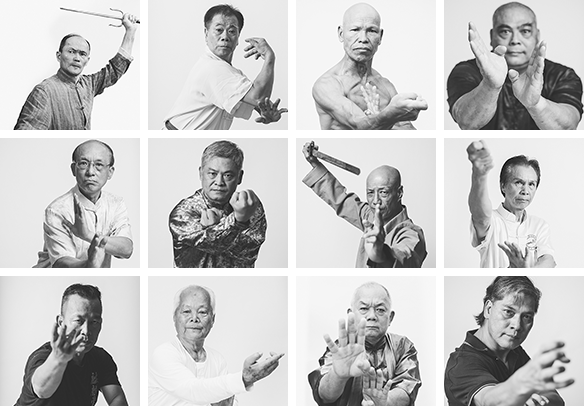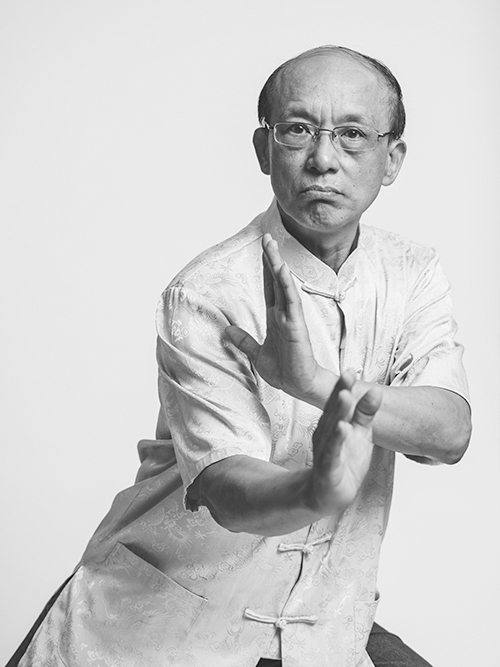Wong Tung Ming, Hakka, was born in 1955 and a native of Fui Chiu Guanyinge (Now called Huisheng Lulan). His grandfather moved to Fui Chiu city in his youth. In late 1979 towards the end of the Cultural Revolution he emigrated illegally to Hong Kong and worked in the interior decoration / renovation industry.
黃東明,1955年出生,廣東惠州觀音閣客家人(現時惠城區盧嵐)。爺爺年青時在惠州市內定居。1979年年末文革時期偷渡來港,從事裝修工程業務。
In 1972 during the Cultural Revolution, Wong Tung Ming completed his secondary studies and was assigned to work at a construction company as a cement worker. When they were at school several of his close friends, all of the Wong clan, took martial arts instruction from various masters in Fui Chiu city, including masters of Faat Gar (Buddhist Fist), Pak Mei (White Eyebrow), Lung Ying (Dragon Style), etc. They all practiced gymnastics and acrobatics at school, and so their general physical conditioning was quite good and had good coordination and agility. However, even though Wong Tung Ming dabbled in the martial arts through exchanges with various masters and his own friends, he did not systematically study any martial arts at this stage.
1972年,正值文革時期,黃東明高中畢業後由學校分配工作,分配到一家建築公司,當泥水工人。他有幾位很要好朋友,都姓黃的,大家在學校時已經常常結伴拜訪惠州市內不同門派的師傅,同時不固定地跟不同的師傅學藝,如佛家拳、白眉、龍形等。由於他們在學校熱沖體操、雜技等體育鍛練,身體素質錯,相比較靈活。但雖然接觸了很多不同門派的師傅、朋友,黃東明卻未正式系統地習武。
One time when he was with his friends they suggested him to take up formal discipleship with a master. One of his friends (of the Wong clan) mentioned there was a kung fu master living in a Chiuchow-speaking village near Fui Chiu Suikou Aobei Guanyinge. Wong Tung Ming was also aware of this village, which he passed through every time he went back to Goon Yam Gok. It was a single-surname village where all the villagers belonged to the Wong clan, and there was an old man who taught kung fu. As Wong Tung Ming did not speak their dialect he only knew the master as “Bing Gung”, who was around eighty years old at the time. His kung fu had been passed down within the Wong lineage. Keeping to this tradition Old Wong only taught male scions from his village. The master was a private man and did not allow his students to have any contact with his family. Wong Tung Ming only came to know his master had a son in Beijing in 1978, when “Bing Gung” said he had to go to Beijing to look after his grandson. In the end he passed away in Beijing.
有一次,他跟幾位朋友聚在一起,談到不如正式拜師學功夫,正好有位姓黃的朋友,提到自己在惠州水口澳貝觀音閣的一個講鶴佬話的村子,有位功夫師傅。黃東明亦發現每次回觀音閣都經過這條村子。村裡面有一位姓黃的老師傅在專門教功夫。因為言語不通,黃東明不知道師傅的名字,只稱他為炳公,當年約八十歲。功夫是家傳的,只教黃姓的人,並且只能由兒子,子孫繼續傳。老師傅晚上才教自己村民功夫。他不讓徒弟接觸家人的,1978年黃東明才知道師傅有一個兒子在北京,因為黃老說要去北京照顧孫子,最後在北京去世了。
Back then it took two hours to get to Guanyin Pavilion from Fui Chiu by bicycle. Wong Tung Ming was enthusiastic and curious about this master, so he arranged a visit with his friends. According to Wong Tung Ming, Aobei was a big village. There was a slope as soon as one walked into the village, with the settlement laying out down below. The entire village was set on a slope with one house next to another, and in this way made up countless rows of houses. The lay of the village was rather complex, and in order to get to the house next door it was necessary to go down a sloping path. In the middle of the village there was a place for villagers to practice martial arts. There was a dragon-eye tree with a flat area beneath its umbrage. At first Old Wong refused to teach Wong Tung Ming. Later someone mentioned the name of his grandfather and the old master allowed him to join the class. Wong Tung Ming only knew the martial arts he learnt in Aobei village from 1972 to 1979 was known as “Hung Kuen”. As he did not speak their dialect he could not investigate further. There were around four to five people in the group. They lit a single water lamp and practiced mostly in the dark. Each time they practiced for two to three hours. He would pass the night in his friend’s house and ride home the next morning. Before the Cultural Revolution Old Wong ran a school in the village, but it was closed down during the Revolution and he only taught a handful of young villagers. For this reason he never charged any fees.
當時由惠州市騎自行車到觀音閣要兩個小時,黃東明很有興趣及很好奇,於時跟住在該村的朋友去拜訪了。據黃東明,澳貝是面積很大的村子,一進村子就需下一個鈄坡,下了坡就見村莊,但村落不是在平坦的地面,而是屋子沿斜坡一座接一座建立,由無數條巷子連接。去旁邊的屋子,也要下一個斜路才能到達,地形很複雜。當中有一處地方給人練武,有棵龍眼樹,樹下正好一個平坦的地方可以練武。黃老起初不知道他姓黃,不肯教。後來有人提起黃東明的爺爺,老師傅才準許他一起學功夫。黃東明只知道在1972年至1979年間在澳貝村學的叫洪拳,但由於語言不通,沒有深究下去。當時有四、五人一起練。點一座火水燈,摸黑來練,每次練兩三個小時,練完就朋友家休息,第二天早上騎自行車回家。黃老原來在文革前在村中開設武館的,文革關閉只教子侄一些防身的功夫,因此由始至終沒有向黃東明等人收學費。
By the end of 1979 Wong Tung Ming knew his elder sister had established comfortably in Hong Kong and he decided to join her. He was caught twice but succeeded in the third attempt. At first he worked as a renovation worker in Sham Shui Po district. He felt Hong Kong was a safe place and that kung fu was not very useful, as fighting was illegal, so he stopped practicing movement sets altogether, but kept up an irregular practice of isolated movements for self-protection. Wong Tung Ming married in 1988. One day his wife woke up with severe pain in her back. After medical check-up at the hospital, the doctor found a red mark on her back, which developed some swelling, but was unable to identify its cause. Later Wong Tung Ming guessed he might have hurt his wife by accident when he was dreaming, so from then on he further reduced his martial art practice.
1979年年底,黃東明得知在香港生活的大家姐生活不錯,決定偷渡到香港,第三次才成功,被人抓回去兩次。最初來到香港的深水埗 區,做裝修工人,覺得練了功夫似乎沒有什麼實質用處,香港社會比較太平,打鬥犯法,因此也較少練習套路,只是不定期練習散手以防萬一。黃東明1988年結婚,有一次太太起床身上感到痛楚,因此到醫院檢查,醫生檢查後發現她身後有一處紅腫,也查不出原因。之後黃東明猜測是否自己發夢時不慎傷到太太,因此後來減少了練習量,空餘隨意練一些散手就算了。
In 2012 Wong Tung Ming visited Sheung Wo Hang village in Sha Tau Kok with Fu Tin Song. The purpose of that trip was to visit Li Chuen Lam, who is Fu Tin Song’s si suk, but they also share a common interest in unicorn dance. Through Li Chuen Lam they met Li Tin Loy. In the same year Li Tin Loy invited Wong Tung Ming to perform martial arts at Kowloon Park. Wong Tung Ming is one of the founding members of Hakka Kung Fu Culture Research Society, which was established in 2015.
2012年,黃東明有次跟傅天宋到沙頭角上禾坑村。由於李春林是傅天宋的師叔,黃東明一方面陪同傅天宋探望李春林,另一方面也是愛好客家麒麟,因此到李春林處交流,從而認識了李天來。同年,李天來邀請黃東明參與九龍公園功夫閣表演。2015年客家功夫文化研究會成立,黃東明為創會成員之一。





